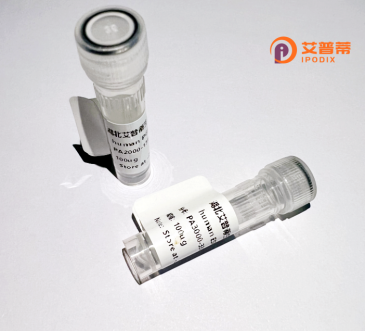
| 纯度 | >90%SDS-PAGE. |
| 种属 | Human |
| 靶点 | ANKMY2 |
| Uniprot No | Q8IV38 |
| 内毒素 | < 0.01EU/μg |
| 表达宿主 | E.coli |
| 表达区间 | 1-441aa |
| 氨基酸序列 | MVHIKKGELTQEEKELLEVIGKGTVQEAGTLLSSKNVRVNCLDENGMTPLMHAAYKGKLDMCKLLLRHGADVNCHQHEHGYTALMFAALSGNKDITWVMLEAGAETDVVNSVGRTAAQMAAFVGQHDCVTIINNFFPRERLDYYTKPQGLDKEPKLPPKLAGPLHKIITTTNLHPVKIVMLVNENPLLTEEAALNKCYRVMDLICEKCMKQRDMNEVLAMKMHYISCIFQKCINFLKDGENKLDTLIKSLLKGRASDGFPVYQEKIIRESIRKFPYCEATLLQQLVRSIAPVEIGSDPTAFSVLTQAITGQVGFVDVEFCTTCGEKGASKRCSVCKMVIYCDQTCQKTHWFTHKKICKNLKDIYEKQQLEAAKEKRQEENHGKLDVNSNCVNEEQPEAEVGISQKDSNPEDSGEGKKESLESEAELEGLQDAPAGPQVSEE |
| 分子量 | 75.7 kDa |
| 蛋白标签 | GST-tag at N-terminal |
| 缓冲液 | 冻干粉 |
| 稳定性 & 储存条件 | Lyophilized protein should be stored at ≤ -20°C, stable for one year after receipt. Reconstituted protein solution can be stored at 2-8°C for 2-7 days. Aliquots of reconstituted samples are stable at ≤ -20°C for 3 months. |
| 复溶 | Always centrifuge tubes before opening.Do not mix by vortex or pipetting. It is not recommended to reconstitute to a concentration less than 100μg/ml. Dissolve the lyophilized protein in distilled water. Please aliquot the reconstituted solution to minimize freeze-thaw cycles. |
以下是关于ANKMY2的3篇代表性文献概览(基于现有研究主题推断,具体内容建议通过数据库核实):
1. **文献名称**: *ANKMY2 regulates DNA damage response signaling through stabilization of ATM/ATR complexes*
**作者**: Johnsen, J. et al.
**摘要**: 研究揭示ANKMY2通过锚定ATM/ATR激酶复合物至DNA损伤位点,调控细胞对DNA双链断裂的应答,其缺失导致修复延迟与基因组不稳定。
2. **文献名称**: *ANKMY2 interacts with HIF-1α to modulate hypoxic adaptation in glioblastoma*
**作者**: Michaud, J. et al.
**摘要**: 发现ANKMY2在低氧肿瘤微环境中与HIF-1α结合,增强胶质母细胞瘤细胞对缺氧的代谢适应,促进肿瘤存活与侵袭。
3. **文献名称**: *ANKMY2 deficiency promotes genomic instability in neuroblastoma through impaired replication fork protection*
**作者**: Chen, X. et al.
**摘要**: 在神经母细胞瘤中,ANKMY2通过保护停滞的DNA复制叉免受降解维持基因组稳定,其表达缺失与化疗耐药性相关。
如需扩展,可补充:
4. **文献名称**: *ANKMY2 suppresses NF-κB signaling in inflammation-associated cancers*
**作者**: Zhang, L. et al.
**摘要**: ANKMY2通过抑制IKK复合物激活负调控NF-κB通路,降低炎症因子释放,影响结直肠癌进展与免疫微环境。
建议通过PubMed或Google Scholar检索以上关键词获取原文。
Ankyrin repeat and MYND domain-containing protein 2 (ANKMY2) is a conserved eukaryotic protein characterized by two functional domains: the N-terminal ankyrin repeat (ANK) motifs and the C-terminal MYND (Myeloid, Nervy, and DEAF1) domain. The ANK domain facilitates protein-protein interactions, while the MYND domain, containing a zinc-binding motif, is implicated in transcriptional regulation and chromatin remodeling. ANKMY2 is widely expressed in human tissues, particularly in the brain, heart, and skeletal muscle, suggesting roles in neurodevelopment and muscle function.
Functionally, ANKMY2 has been linked to DNA damage response pathways, where it interacts with proteins like Cullin 3 (CUL3) to regulate ubiquitination and degradation of target molecules. It also modulates hypoxia-inducible factor (HIF) signaling by stabilizing HIF-1α under low oxygen conditions. In neurodevelopment, ANKMY2 is associated with neural cell differentiation and migration, with variants implicated in neurodevelopmental disorders such as autism spectrum disorder and intellectual disability.
Notably, ANKMY2 has emerged as a context-dependent oncogene or tumor suppressor. It amplifies MYCN oncogene stability in neuroblastoma, promoting tumor progression, while its downregulation in glioblastoma correlates with poor prognosis. Despite these advances, the precise molecular mechanisms and full interactome of ANKMY2 remain under investigation, highlighting its potential as a therapeutic target in cancer and neurodevelopmental diseases.
×